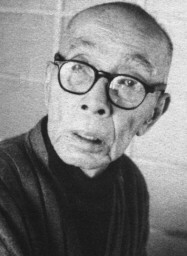|
SŰke
Toshitsugo Takamatsu
33rd Grandmaster of the
Togakure Rye Tradition
By Joe Maurantonio
Toshitsugu Takamatsu was called Jutaro as a young child. He
was born on March 10, 1889 in Akashi, Hyogo Prefecture and was a descendent of
the Daimyo of Hosokubi Castle in Ise at Matsugashima. At age nine, the young
Takamatsu was taken by his father to see their relative Masamitsu Shinryuken
Toda, who ran a bone setting clinic and a Budo Dojo. After explaining that the
young man was often teased by his classmates and called "cry baby," Takamatsuís
father asked Toda Sensei what he thought should be done? "Martial practices will
be best for him. Strict disciplines will make him strong and courageous."

Training began with Takamatsu being thrown about, regardless
of any pain, by Toda Sensei. But since a good nightís rest wiped away his memory
of the previous day he kept returning to the dojo. After about a year of this
training Toda Sensei began showing Takamatsu the waza of Shinden Fudo Ryu. By
about the age of thirteen years old he had mastered the skills of Shinden Fudo
Ryu so Toda began teaching the young Takamatsu Koto Ryu Koppojutsu and Togakure
Ryu ninjutsu. Though the Koto and Shinden Fudo Ryu were very enticing to the
young martial artist he didnít really enjoy the lessons of ninjutsu training.
Takamatsu began studying the martial arts with great fervor.
At the age of 12 he would do randori with his seniors at the dojo and none could
put him down. He was nicknamed Kotengu ("little demon") and the days of his
being called "cry baby" were left behind. Towards the end of his third year of
training with Toda Sensei, Takamatsuís father sent him to study at an English
school in Kobe. Here he joined the dojo of Tadafusa Yoshitaro Mizuta and began
studying Takagi Yoshin Ryu Jujutsu. Since he had already achieved the skill of
Menkyo ("licensee") in Shinden Fudo Ryu he was taught this Jujutsu at an
accelerated level. Yet, even though he trained at day and night sessions, he
would visit and train with Toda Sensei whenever possible. Several years later
(c. 1906), while working for his father in Akashi City, he met and began
training with Matsutaro Ishitani in Kukishinden Ryu Happo Biken, Hontai Takagi
Yoshin Ryu and several other arts.
By the year 1909 (at the age of 20) he had received Menkyo in
all the arts listed above (as well as a few others). In 1910 he travelled to
China, after being denied a position in the Japanese army because of his damaged
right ear drum. Becoming gravely ill he returned to Japan the following year and
spent several season on Mount Maya recuperating and practicing his martial
skills. Here he met an old hermit who helped nurse him back to health and taught
him many things about nature. The subsequent year he returned to China and
Manchuria and spent the next decade there. These were turbulent times and no man
travelled unimpeded. According to Takamatsuís diary he fought over a dozen duels
to the death and a half dozen competition matches. One of my favorite stories
about Takamatsu Sensei martial exploits in China is:
At the age of 26 Takamatsu was living in China. He taught
many students and because of this was challenged by a Shorinji Kung Fu master
named Choshiryu. Though he twice refused to fight, he later accepted Choshiryu's
third challenge so as not to offend his martial valor.
Choshiryu was taller, stronger and weighed much more than
Takamatsu. But when the referee called the match to begin, neither hesitated,
both leapt to attack. A crowd gathered and the battle raged. Choshiryu launched
punches and kicks at Takamatsu who defended and reciprocated with attacks of his
own. They were evenly matched and the fight seemed to last for hours. Then, just
as Takamatsu was about to strike down the out of breath Choshiryu, the referee
called the match over. Catching his breath, Choshiryu approached Takamatsu and
congratulated him for such a good fight. Admiring each others skill, both went
out to a nearby restaurant, talked and drank late into the night. In time, both
became the greatest of Buyu, "martial friends."
This article reprinted from the
www.Kihon.com, with the author's kind
permission. |



